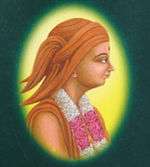Gopalanand Swami
| Gopalanand Swami | |
|---|---|
| Born |
Khushal Bhatt 17 October 1785 Arvalli District's, Torda Village of Bhiloda Taluka, Gujarat, India) |
| Died |
11 October 1867 (aged 81) Vadtal, British India (present-day Gujarat, India) |
| Guru | Swaminarayan |
| Part of a series on |
| Vaishnavism |
|---|
 |
|
Sampradayas |
|
Philosophers–acharyas |
|
Related traditions |
|
|
| Part of a series on | ||
| Hindu philosophy | ||
|---|---|---|
 | ||
| Orthodox | ||
|
|
||
| Heterodox | ||
|
|
||
|
||

Gopalanand Swami (1781–1852) was one of the top most prominent paramhansa of the Swaminarayan Sampraday who was ordained by Swaminarayan. He worked alongside Gunatitanad Swami to to spread the Swaminarayan Satsang. Gopalanand Swami, Gunatitanand Swami, Brahmanand Swami & Premanand Swami are considered to be the most prominent saints in Hinduism. It is believed & Factually proven in the Swaminarayan scriptures that Brahmanand Swami was the embodiment of Lord Brahma one of the Hindu trinity, Premanand Swami was considered to be an musical & vocals saint from heaven, Gopalanand Swami is said to be the Lord Vishnu himself the most supreme of the three trinities & Gunantitanand Swami is said to be the living saint of Akshardham he is abode of Bhagwan Swaminarayan.
Biography
Born Khushal Bhatt, he was born in the Arvalli District's, Torda Village of Bhiloda Taluka, Gujarat. Torda is surrounded by mountains. His father was an audichiya brahmin, Motiram Sharma and his mother was Kushaladevi Thakar. Gopalanand Swami pursued deep study and showed great interest of grammar, Indian philosophy of Nyaya and Vedanta. Gopalanand Swami was a scholar, with knowledge in Vyakaran (grammar), Nyaya, Mimasa, Astrology etc. He was married to Adityabai and had two children Harisankar and Anupamba though he felt no attachment.[1] Swaminarayan gave diksha (the becoming of a saint in which vows such as celibacy and renunciation of all personal possessions and of all worldly duties, including family ties are taken) to Gopalanand Swami in Vadodara, Gujarat. Swaminarayan held Gopalanand Swami in very high regard and he was very learned in Ashtang yoga. Gopalanand Swami died in 1852 in Vadtal.[2] Gopalanand Swami spread the belief & reality that Bhagwan Swaminarayan is the Supreme Being higher than all.He is still alive with divine body,along with hanumanji, in salangpur.
Responsibility of the Swaminarayan Sampraday
When the Swaminarayan died (Gadhadha, year 1830), he left responsibility of the Swaminarayan Sampraday and the Acharyas in his hands.[3] Further, it is said that Swaminarayan had asked Brahmanand Swami to overlook the completion of the Junagadh Temple because he knew Brahmanand Swami had powers to bring a person back to life after death. He therefore instructed Gopalanand Swami not to inform Brahmanand Swami about his death till after the cremation of his mortal remains.[2]
Sarangpur temple
Gopalanand Swami arranged for an idol of Kastabhanjan Dev Hanuman to be installed in the Sarangpur temple which is said to have come alive and moved when installed by him.[4] He wanted to see the idol of Hanuman interactive.
Works[5]
Sanskrit Books
- Vivekdeep
- Vishnuyaag Paddhati
- Pujavidhi
- Bhakti Siddhi
- Haribhakta Namavali
- Brahmasutrarthdeep
- Ishadi Upanishad Bhashya
- Shreemad Bhagwad Geeta Bhashya
- Commentary on Second Canto of Shreemad Bhagwat (Sukabhipray Bodhini Tika)
- Dasham Skandh Goodharth Bodhini Tika
- Ekadash Skandh Krushnabhipray Bodhini Tika
- Ved Stuti Shrutyarth Bodhini Tika and Anvayarth Bodhini Tika
- Shandilya Sutra Bhakti Prakashika Tika etc.
Vernacular Books
- Varta Vivek
- Advait Khandan
- Marathi Translation of Shikshapatri
- Updeshi Vartao
- Puja Paddhati na Pana
- Bhaktisiddhi Bhashantar (Translation of Bhaktisiddhi)
- Sampraday Pradeep
Notes
- ↑ http://www.swaminarayanwales.org.uk/?ID=Gopalanand_Swami
- 1 2 Nand Santos - Gopalanand Swami
- ↑ Williams 2001, pp. 35, 36
- ↑ Williams 2001, pp. 128
- ↑ Shee Gopalanand Swami ni Vato. Sardhar: Shree Swaminarayan Mandir Sardhar. 2008. p. 27.
References
- Williams, Raymond (2001), Introduction to Swaminarayan Hinduism, Cambridge University Press, ISBN 978-0-52165-422-7

